 Those of you who follow closely this blog may remember that I gave a seminar on Higgs boson searches at the Tevatron two months ago in Louvain, Belgium. After the visit to Louvain, I noted here that it takes one a substantial amount of work to prepare a well-constructed seminar, regardless of how well one knows the topic. And I ventured to hypothesize that among my readers there could be somebody willing to invite me, to give an updated version of the same seminar at some other university or institute, preferably located in some interesting place to visit.
Those of you who follow closely this blog may remember that I gave a seminar on Higgs boson searches at the Tevatron two months ago in Louvain, Belgium. After the visit to Louvain, I noted here that it takes one a substantial amount of work to prepare a well-constructed seminar, regardless of how well one knows the topic. And I ventured to hypothesize that among my readers there could be somebody willing to invite me, to give an updated version of the same seminar at some other university or institute, preferably located in some interesting place to visit.My wish materialized overnight when Martin Alonso, a PhD student at IFIC Valencia, took contact with me to organize a presentation there. As I write these notes, I am in the Valencia airport, homebound after two very pleasant days. The people I met at IFIC were very kind and interesting, the city is quite beautiful to visit, and the food I ate there was spectacular. But the most fulfilling part of the trip was, indeed, the seminar.
I hope my colleague Andrea Giammanco, who first invited me to Louvain, will not resent the fact that I am claiming my presentation in Valencia was appreciably better. Of course, unless you are really dumb you learn from your mistakes: and although my talk in Louvain was reasonably good, after giving it I realized I might cut some material, reshape some other, cite a few more papers, and include the latest results of searches that had not been published before February. The reshaped seminar received a very positive feedback at IFIC, where I got the attention of about thirty among staff physicists and graduate students, despite the absence of many for Easter vacations.
I would be happy to advertise the package further, in the hope to collect other invitations; but I am traveling way too much these days, so for a while I will stop willfully overburdening my schedule -unless invitations come from really appealing places! Instead, let me reproduce here, amended and simplified, the part of the seminar where I discussed the future of the Higgs boson searches, and the scenarios that are taking shape in front of us.
2013: The Higgs is found, or excluded, or ...
One needs several ingredients in order to put together a meaningful prediction for when, how, and by whose hands this now over thirty-year-long saga of the Higgs boson will get to an end. But it so happens that those ingredients are available today, and for the first time we have a rather credible way of extrapolating both Tevatron reach and LHC reach at least three years in the future. There are, in fact, some factors making this particular moment of time a good pick to play the "seer".
First of all, the Tevatron: Higgs searches there have become stable in their output, in the sense that the technology is quite refined, and it is not foreseen to improve significantly in the future (at least by yours truly). It might, but taking what now exists as a basis for extrapolation is a conservative, sound approach, and the one I will follow.
Second, the LHC has finally started running at 7 TeV energy in the center-of-mass. The first W bosons are timidly popping up already! This means that the ball is rolling, and I do not think there are significant caveats in trusting the integrated luminosity profile versus time that the LHC machinists have predicted for the next two years, helium blowups allowing. And it also means that we can reliably take it for granted that CMS and ATLAS will be looking at roughly one inverse femtobarns of data by the end of 2011.
And third, much of the hard work has been already done by CDF some time ago. Basically the CDF predictions are provided in the form of two pairs of plots, which are shown below. The first pair describes the 95% confidence-level limits on the ratio R between excluded Higgs cross section and standard model expectation, for two significant values (115 and 160 GeV) of the Higgs mass: if R=1 is excluded, then the Higgs is disfavored to exist at the corresponding mass.
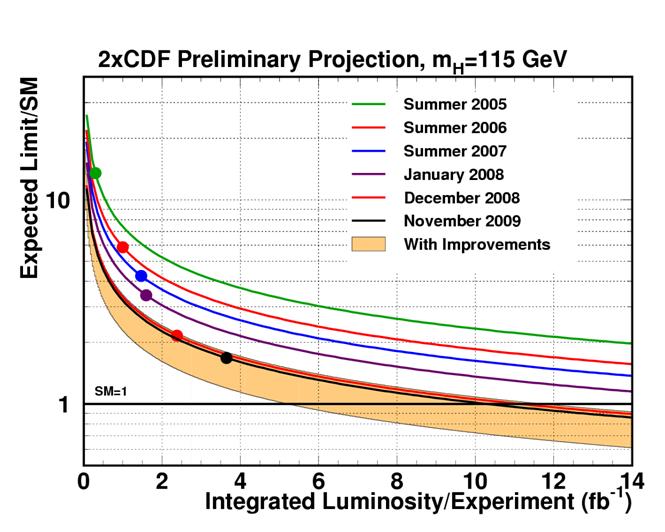
Above, expected 95% confidence-level limits on the ratio between production cross-section of a 115-GeV Higgs boson and its standard model prediction (on the vertical axis) are shown as a function of available integrated luminosity (on the horizontal axis), in the hypothesis of (1) a combination CDF and DZERO searches, in the further hypothesis (2) that DZERO analyses at low mass become as strong as the ones by CDF (they are significantly less stringent presently), and in the final hypothesis that (3) the data follow the expectation of the background (as opposed to producing a unlikely fluctuation upward or downward, which may change the picture quite sizably).
The black like, which passes through the most recent CDF result (doubled in sensitivity to incorporate hypothesis 1) corresponds to a simple scaling of the R limit with the square root of the integrated luminosity on which the analyses are based. The colored points and curves refer to earlier instantiations of the same analysis, which were less powerful and thus exploited less well the available data.
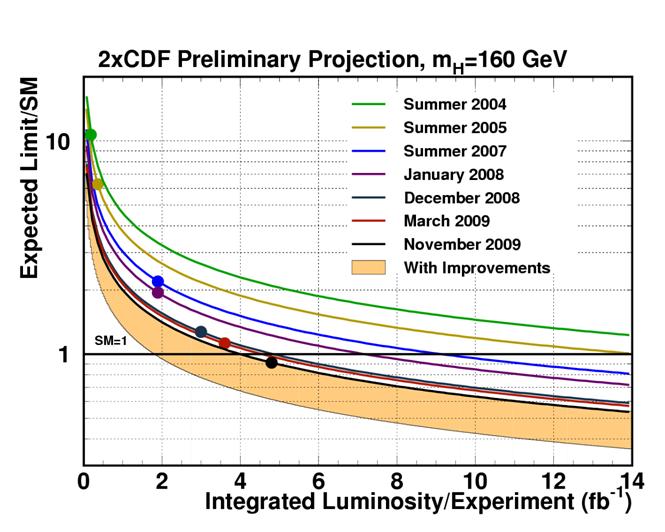
Above you may instead see the twin plot corresponding to a 160 GeV Higgs boson search. As before, you may note how the limit has become more and more stringent with increases in luminosity, scaling way more steeply than what the data increase predicted. The reason is that the time between the various results was used successfully by the experiments to improve the precision and care of their results. But let us concentrate on the future, not on the past.
Instead, before I start discussing the power of Tevatron searches to actually see a signal if one is there, let me stress one point about these plots. What is shown is the power of the data and its analysis; even if future data should withstand a statistical fluctuation, the results shown would still stand -because they are not actual results but averages, or rather medians. A wild fluke might make the exclusion significantly stronger, or weaker. For instance, a 115-GeV Higgs boson might have already been excluded with 5 inverse femtobarns of CDF and D0 data, if backgrounds had fluctuated down by about 2.5 standard deviations!
Once that is clear, let us examine the second pair of graphs: these are a different kind of sensitivity reach plots, again produced over a year ago. They still constitute our best predictions for the chance of a Higgs boson sight; actually, the recent developments -Tevatron performance and added improvements in the analyses- make the predictions more trustable. These plots show, as a function of the Higgs boson mass (on the horizontal axis), the probability (on the vertical axis) that CDF and DZERO, by combining their 5- (in red) or 10- (in blue) inverse femtobarns datasets, may obtain a 2-standard-deviation excess due to Higgs bosons, if that particle exists at that mass. Please ignore the dashed lines, which represent the case of further improvements in the analysis techniques which I doubt will ever be possible. Still, you can observe that the probability of a 2-sigma excess is quite sizable, and even a 3-sigma evidence is possible if the Tevatron gets lucky.
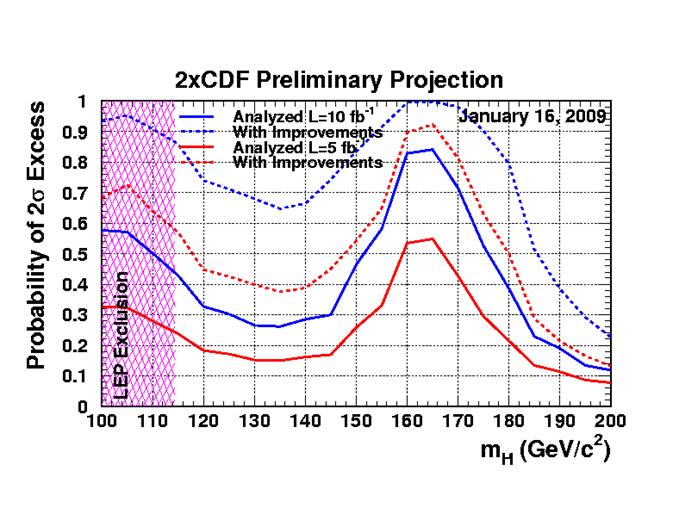
Above, the probabilities for a 2-sigma excess as a function of Higgs mass, with 5- and 10-inverse-femtobarns.
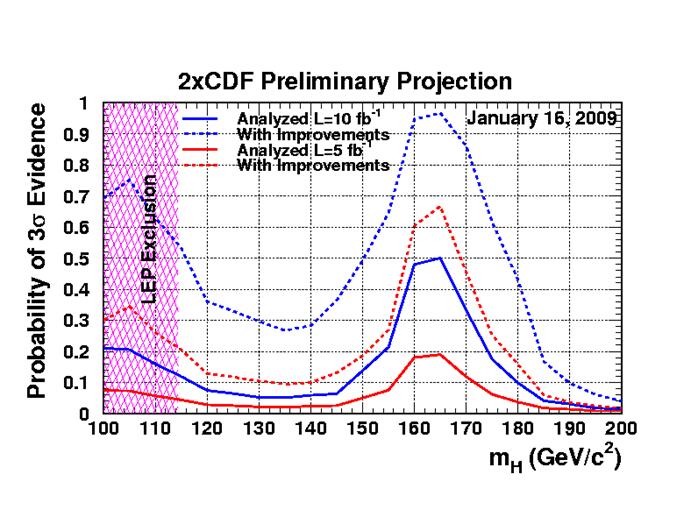
And above, the probability of a 3-sigma evidence as a function of Higgs mass.
Including Luminosity estimates and LHC predictions in three scenarios
None of what I showed above is new to you, if you have followed this blog in the course of the past year. Yet we can build something more interesting with that information. We need some more input to make more precise predictions on what will happen in the next few years, on the west side of the Atlantic. We need to know what is the total integrated luminosity that CDF and DZERO will be able to analyze, and when.
Please have a look at the graph below: it shows the integrated luminosity that the Tevatron collider delivered to the experiments as a function of time. The curve has followed an almost exponential trend: it has fulfilled our wildest dreams of five years ago, delivering data in perfect accordance to a "design plan". Including the now customary yearly shutdowns of two months, the machine now produces over 2 inverse femtobarns per year.
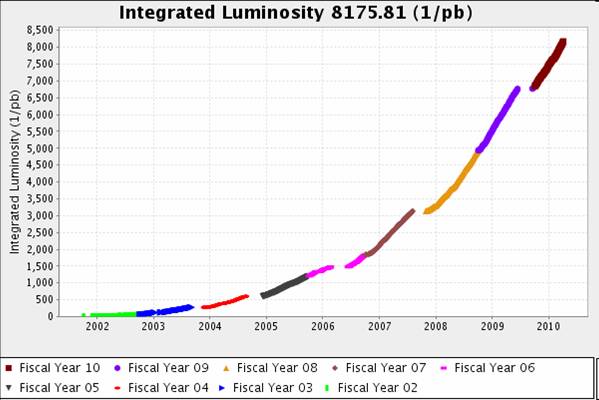
With that trend in mind, we can extrapolate to the end of 2011, which is the probable date when the Tevatron will stop running for good. It does not make much sense, in fact, for the US Department of Energy to spend over 200 million dollars a year running a machine that is now outdated by the LHC startup: every additional year of running would add only 10% more reach for discoveries and measurements (2 femtobarns over 10 is 20% luminosity, or 10% statistical power).
So by the end of 2011 it is a safe bet to claim that the Tevatron will have delivered about 11 inverse femtobarns of data to the experiments. This translates in a bit less than 10 inverse femtobarns of collected collisions (the efficiency is never 100%, for several reasons which would get this post wildly off-topic).
In Europe, in the meantime, the LHC will deliver one inverse femtobarns of data to ATLAS and CMS. There exist predictions for the reach of these experiments in the search for the Higgs boson, but they were computed assuming 10 or 14 TeV collisions. At 7 TeV, the Higgs boson has a cross section which is twice smaller; backgrounds are also smaller, but the net result is a significant hit in sensitivity. It is however possible to make some extrapolations and compute the sensitivity that a combination of ATLAS and CMS data will have on the Higgs boson. I did the exercise, and have my own results.
Putting everything together, I can now post here a slide of the seminar, showing three different scenarios for what will happen by 2012.
Three Scenarios
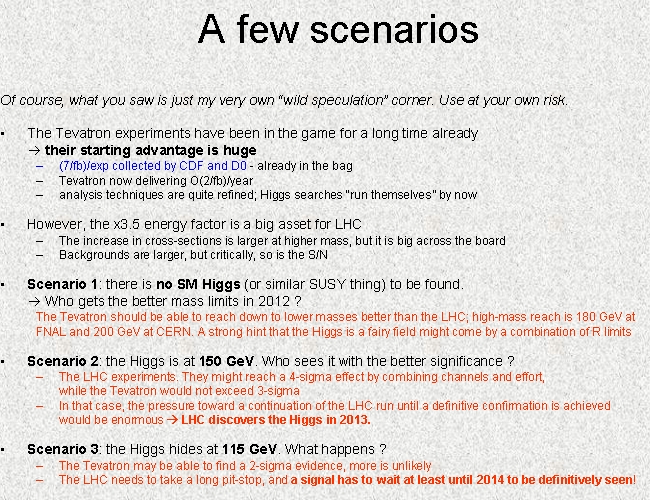
As usual, my slides are quite descriptive, so there is little to comment on. It is important, however, to note that the existence of the "standard-model-like" Higgs boson is what makes a difference: if the Higgs exists, it will most likely be found by the LHC experiments. If it does not exist, however, it will be the Tevatron to rule it out first.
Maybe one more thing to note remains to be made. The title of this post suggests that by 2012 the Higgs might be found and its mass known: this, for particle physicists, usually implies a 5-sigma excess of signal events. But it needs not be so: in 1994, for instance, the top quark was found by CDF, and its mass was measured (with excellent accuracy, as demonstrated later). That was not a discovery, since the effect amounted to only three standard deviations; the discovery came one year later, by both CDF and DZERO together. Nevertheless, by 1994 everybody was convinced that the top quark was there. And those who doubted were later proven wrong... So if you are not a blind sceptic, 2012 may be the year for the Higgs as well!
And one final remark: however it goes, the next two years will be quite exciting!




Comments